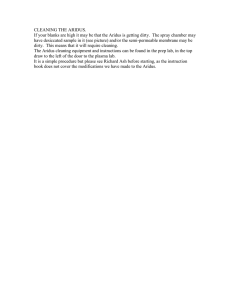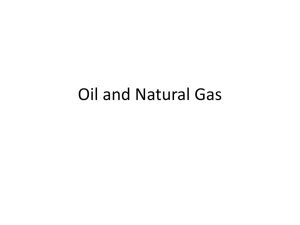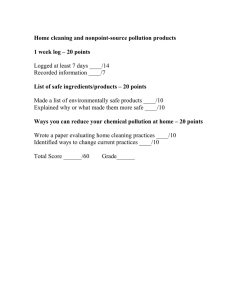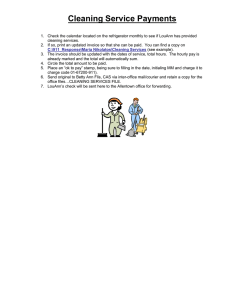Surface Preparation Guide - Sherwin
advertisement
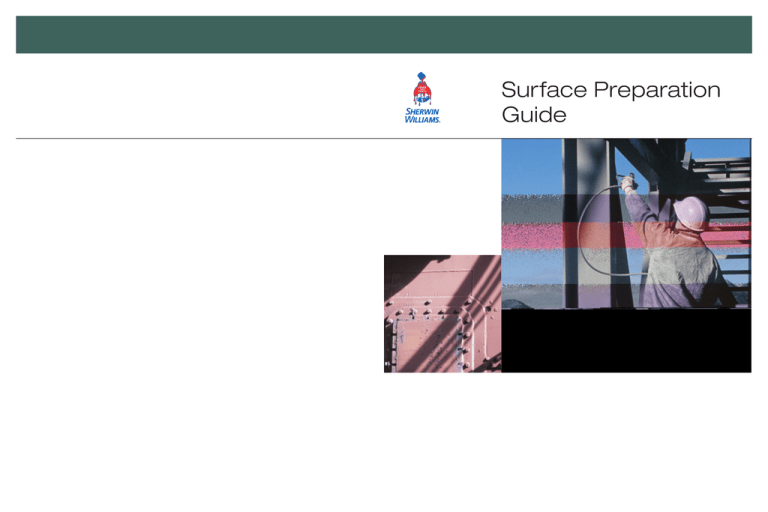
Surface Preparation Guide B SP-5 Surface Preparation Coating performance is directly affected by surface preparation. Coating integrity and service life will be reduced because of improperly prepared surfaces. As high as 80% of all coating failures can be directly attributed to inadequate surface preparation that affects coating adhesion. Selection and implementation of the proper surface preparation ensures coating adhesion to the substrate and prolongs the service life of the coating system. The majority of paintable surfaces are concrete, ferrous metal, galvanizing and aluminum. They all require protection to keep them from corroding in aggressive environments. Selection of the proper method for surface preparation depends on the substrate, the environment, the coating selected and the expected service life of the coating system. Economics, surface contamination and the environment will also influence the selection of surface preparation methods. Previously Coated Surfaces Maintenance painting will frequently not permit or require complete removal of all old coatings prior to repainting. However, all surface contamination such as oil, grease, loose paint, mill scale, dirt, foreign matter, rust, mold, mildew, mortar, efflorescence and sealers must be removed to assure sound bonding to the tightly adhering old paint. Glossy surfaces of old paint films must be clean and dull before repainting. Washing with an abrasive cleanser will clean and dull in one operation, or, wash thoroughly and dull by sanding. Spot prime any bare areas with an appropriate primer. Recognize that any surface preparation short of total removal of the old coating may compromise the service life of the system. Check for compatibility by applying a test patch of the recommended coating system, covering at least 2 to 3 square feet. Allow to dry one week before testing adhesion per ASTM D3359. If the coating system is incompatible, complete removal is required. Touch-Up, Maintenance and Repair For a protective coating system to provide maximum longterm protection, regularly scheduled maintenance is required. Maintenance includes inspection of painted areas, cleaning of surfaces to remove oils, chemicals, and other contaminants, and touch-up of areas where the coatings have been damaged. Highly corrosive areas, such as those subjected to frequent chemical spillage, corrosive fumes and/or high abrasion or temperature, should be inspected frequently – every six months, for example. Areas exposed to less severe conditions, such as interiors and exteriors of potable water tanks, may be inspected annually to assess the condition of the coating system. The SSPC-VIS 2, Standard Method for Evaluating Degree of Rusting on Painted Steel Surfaces, can be used as a guide to determine appropriate touch-up and repair maintenance schedules. 080206_PMP_Surface 2 B SP-10 B SP-6 B SP-7 Rust Grade B Non-Ferrous Metal Surfaces and Concrete SSPC/NACE Standards Aluminum SSPC-SP1 – Solvent Cleaning SSPC-SP10/NACE 2 – Near White Blast Cleaning Remove all oil, grease, dirt, oxide and other foreign material by cleaning per SSPC-SP1, Solvent Cleaning. Solvent Cleaning is a method for removing all visible oil, grease, soil, drawing and cutting compounds and other soluble contaminants. Solvent cleaning does not remove rust or mill scale. Change rags and cleaning solution frequently so that deposits of oil and grease are not spread over additional areas in the cleaning process. Be sure to allow adequate ventilation. For complete instructions, refer to Society of Protective Coatings Surface Preparation Specification No.1. A Near-White Blast Cleaned surface, when viewed without magnification, shall be free of all visible oil, grease, dirt, dust, mill scale, rust, paint, oxides, corrosion products and other foreign matter, except for staining. Staining shall be limited to no more than 5 percent of each square inch of surface area and may consist of light shadows, slight streaks or minor discoloration caused by stains of rust, stains of mill scale or stains of previously applied paint. Before blast cleaning, visible deposits of oil or grease shall be removed by any of the methods specified in SSPC-SP1 or other agreed upon methods. For complete instructions, refer to Joint Surface Preparation Standard SSPC-SP10/NACE 2. Galvanized Metal Allow to weather a minimum of six months prior to coating. Clean per SSPC-SP1 using detergent and water or a degreasing cleaner, then prime as required. When weathering is not possible or the surface has been treated with chromates or silicates, first Solvent Clean per SSPC-SP1 and apply a test area, priming as required. Allow the coating to cure at least one week before testing per ASTM D3359. If adhesion is poor, Brush Blast per SSPC-SP7/NACE 4 is necessary to remove these treatments. Ductile Iron National Association of Pipe Fabricators, Inc. www.napf.com NAPF 500-03 Surface Preparation Standard for Ductile Iron Pipe and Fittings in Exposed Locations Receiving Special External Coatings and/or Special Internal Linings This standard summarizes the surface preparation requirements for ductile iron. Included within this standard are the following: NAPF 500-03-01 Solvent Cleaning NAPF 500-03-02 Hand Tool Cleaning NAPF 500-03-03 Power Tool Cleaning NAPF 500-03-04 Abrasive Blast Cleaning for Ductile Iron Pipe NAPF 500-03-05 Abrasive Blast Cleaning for Cast Ductile Iron Fittings Attempts to apply steel surface preparation specifications to ductile iron is inappropriate and may actually result in damage to the pipe surface with subsequent reduced coating effectiveness and life expectancy. Concrete International Concrete Repair Institute www.icri.org No. 03732 Guideline for Selecting and Specifying Concrete Surface Preparation for Sealers, Coatings, and Polymer Overlays This standard summarizes the capabilities, operating requirements, and limitations of the various methods used to prepare concrete surfaces for the application of protective sealers, coatings, and polymer overlays. Benchmark profiles are included which provide visual standards for purposes of specification, application and verification. ICRI 03732 identifies 12 different concrete surface preparation methods and uses nine profile replicates to use as a visual standard to ensure the specified Concrete Surface Profile (CSP 1-9) is achieved. SSPC-SP2 – Hand Tool Cleaning Hand Tool Cleaning removes all loose mill scale, loose rust and other detrimental foreign matter. It is not intended that adherent mill scale, rust and paint be removed by this process. Mill scale, rust, and paint are considered adherent if they cannot be removed by lifting with a dull putty knife. Before hand tool cleaning, remove visible oil, grease, soluble welding residues and salts by the methods outlined in SSPC-SP1. For complete instructions, refer to Society of Protective Coatings Surface Preparation Specification No.2. SSPC-SP3 – Power Tool Cleaning Power Tool Cleaning removes all loose mill scale, loose rust and other detrimental foreign matter. It is not intended that adherent mill scale, rust and paint be removed by this process. Mill scale, rust and paint are considered adherent if they cannot be removed by lifting with a dull putty knife. Before power tool cleaning, remove visible oil, grease, soluble welding residues and salts by the methods outlined in SSPC-SP1. For complete instructions, refer to Society of Protective Coatings Surface Preparation Specification No.3. SSPC-SP5/NACE 1 – White Metal Blast Cleaning A White Metal Blast Cleaned surface, when viewed without magnification, shall be free of all visible oil, grease, dirt, dust, mill scale, rust, paint, oxides, corrosion products and other foreign matter. Before blast cleaning, visible deposits of oil or grease shall be removed by any of the methods specified in SSPC-SP1 or other agreed upon methods. For complete instructions, refer to Joint Surface Preparation Standard SSPC-SP5/NACE 1. SSPC-SP6/NACE 3 – Commercial Blast Cleaning A Commercial Blast Cleaned surface, when viewed without magnification, shall be free of all visible oil, grease, dirt, dust, mill scale, rust, paint, oxides, corrosion products and other foreign matter, except for staining. Staining shall be limited to no more than 33% of each square inch of surface area and may consist of light shadows, slight streaks or minor discoloration caused by stains of rust, stains of mill scale or stains of previously applied paint. Before blast cleaning, visible deposits of oil or grease shall be removed by any of the methods specified in SSPC-SP1 or other agreed upon methods. For complete instructions, refer to Joint Surface Preparation Standard SSPC-SP6/NACE 3. SSPC-SP11 – Power Tool Cleaning to Bare Metal Metallic surfaces that are prepared according to this specification, when viewed without magnification, shall be free of all visible oil, grease, dirt, dust, mill scale, rust, paint, oxide corrosion products and other foreign matter. Slight residues of rust and paint may be left in the lower portions of pits if the original surface is pitted. The profile shall not be less than 1 mil. Prior to power tool surface preparation, remove visible deposits of oil or grease by any of the methods specified in SSPC-SP1, Solvent Cleaning, or other agreed upon methods. For complete instructions, refer to Society of Protective Coatings Surface Preparation Specification No.11. SSPC-SP12/NACE 5 – High and Ultra-High Pressure Water Jetting for Steel and Other Hard Materials This standard provides requirements for the use of high and ultra-high pressure water jetting to achieve various degrees of surface cleanliness. This standard is limited in scope to the use of water only, without the addition of solid particles in the stream. For complete instructions, refer to Joint Surface Preparation Standard SSPC-SP12/NACE 5. SSPC-SP13/NACE 6 – Concrete This standard gives requirements for surface preparation of concrete by mechanical, chemical or thermal methods prior to the application of bonded protective coating or lining systems. The requirements of this standard are applicable to all types of cementitious surfaces including cast-in-place concrete floors and walls, precast slabs, masonry walls and shotcrete surfaces. An acceptable prepared concrete surface should be free of contaminants, laitance, loosely adhering concrete and dust, and should provide a dry, sound, uniform substrate suitable for the application of protective coating or lining systems. (Depending upon the desired finish and system, a block filler may be required.) For complete instructions, refer to Joint Surface Preparation Standard SSPCSP13/NACE 6. SSPC-SP7/NACE 4 – Brush-Off Blast Cleaning A Brush-Off Blast Cleaned surface, when viewed without magnification, shall be free of all visible oil, grease, dirt, dust, loose mill scale, loose rust and loose paint. Tightly adherent mill scale, rust and paint may remain on the surface. Mill scale, rust and coating are considered adherent if they cannot be removed by lifting with a dull putty knife after abrasive blast cleaning has been performed. Before blast cleaning, visible deposits of oil or grease shall be removed by any of the methods specified in SSPCSP1 or other agreed upon methods. For complete instructions, refer to Joint Surface Preparation Standard SSPC-SP7/NACE 4. 1/22/08 1:17:05 PM

